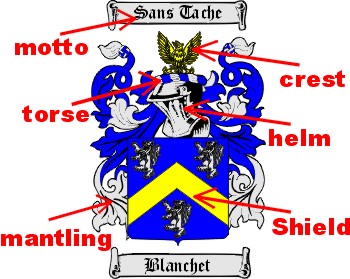![]()
Eltiste-Kaiser Web Site
Coat of Arms Index
There are many different Coat of Arms
For the same Family, Country, Region or Town
I have posted the most Common Coat of Arms
that I have found.......
The Coat of Arms on this web page are for your enjoyment.
There is no claim of that any of them are authentic!!!
A Coat of Arms is also sometimes referred to as a Code of Arms - Family Seal - Family Shield - Family Crest - Wappen
![]()
|
Fink
Index |
Kaiser
Index |
Country
& City
Index |
Rohrs
Index |
Eltiste
Index |
![]()
![]()
Does a coats of arms belong to surnames?
No. There is no such thing as a 'coat of arms for a surname'. Many people of the same surname will often be entitled to completely different coats of arms, and many of that surname will be entitled to no coat of arms. Coats of arms belong to individuals. For any person to have a right to a coat of arms they must either have had it granted to them or be descended in the legitimate male line from a person to whom arms were granted or confirmed in the past.
![]()
What is a Coat of Arms?
Coats of Arms originated in the Middle Ages as a means of distinguishing friend from foe on the Medieval battlefield. Previous to this advent there had been much difficulty in identification of knights. For example, William the Conqueror had to remove his helmet in the midst of the battle of Hastings in order to prove himself to his followers who thought he was killed. The concept developed that each knight would bear a shield of displaying a unique design.
The armour or coat of mail worn in those times generally had a sleeveless
garment called a surcoat worn over it, most likely as protection from the sun.
By the XIIIth century most European knights wore their emblems (also called
bearings or arms) on their surcoats as well as their shields. Thus originated
the expression "Coat of Arms".
By the 13th century, the rules and the terminology that we know today had started to form. Specialists in the field became known as heralds. It was their task to set forth and document all arms in existence to insure that duplication did not occur. Blazon, a heraldic term, originated with the custom of blowing a trumpet to announce the arrival of a knight at the joust or tournament. The blast was answered by the heralds who described and explained aloud the arms borne by the knight.
In ancient times, crests and mottoes may have been used by all, but with the passing of the centuries some have been omitted or forgotten.
With the suppression of private armies, and the gradual disappearance in the 16th century of both tournaments and closed helmets, the sporting and military uses of heraldry became less important and it became rather a decorative art. Coats of arms were carved over doorways, woven on tapestries, placed in stained glass windows and engraved on silver.
![]()
A complete Coat of Arms (correctly referred to as an Achievement of Arms) includes the following elements:
The shield, on which are displayed the symbols (charges).
The helm or helmet, varying in style and positioning according to the rank of the bearer.
The mantling, originally a cloak attached to the helmet as a protection against heat, cold and rain, now adpated into a formal floral design flowing out from both sides of the helmet.
The torse or wreath, consisting of six bands of silk alternately of the colors in the shield, affixed to the helm to hold the crest in place.
The crest, used in ancient times for furthuring identification in battle, today as a traditional symbolic adjunct. Many coats of arms do not have a crest.
The motto, originally, a war cry or slogan. Again, this is not an essential component of a Coat of Arms.
Supporters, animal or human figures, appear on each side of the shield as if holding it upright, lending additional symbolic strength to the achievement. Usually these appear on civic rather than on personal coats of arms.
![]()

![]()
Family Indexes
Home Kaiser Eltiste Fink Rohrs
Thumbnail Family Photo Gallery Index
Last Up-Date 12/01/2007 02:07:13 PM